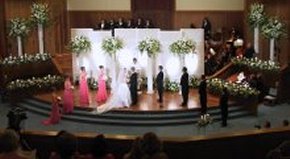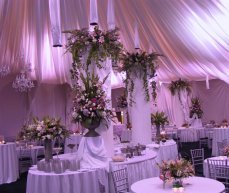Planning a wedding is not without its share of stresses. There are so many choices and decisions to be made, from the wedding date and location to the invitations, to the wedding dress, to the photographer, to the wedding cake, to the music, and on and on. The planning seems almost endless. There is, however, at least one area of wedding planning that should be joyful and uncomplicated: the wedding flowers. In this edition of the newsletter we’ll explore some of the ways to make planning the wedding flowers an easy and stress-free experience.
 |
| Wedding Ceremony |
The first step in planning the wedding flowers is to arrange an appointment with your favorite professional florist for a wedding consultation. This is best done at least six months prior to the wedding date. Most consultations for wedding flowers take between one and two hours, so be sure to allow enough time in your schedule. Prepare for the consultation by gathering pictures from bridal magazines of wedding flowers that appeal to you. Have a list of some of your favorite flowers as well as some that you don’t especially care for. This will make your florist’s job easier when suggesting bouquets and other floral decorations. Bring pictures of the bridal gown and the bridesmaids’ dresses, as well as a sample of the fabrics being used in those dresses. In many cases, it is the color of the bridesmaids’ dresses that determines the palette of colors to be used in the wedding flowers. Also, bring along a picture of the wedding cake if possible. This will help in planning flowers or other decorations for the cake and the wedding cake table.
Make a list of the members of the wedding party and the other people who will be participating in the wedding. Besides the bride and groom, this list should include the maid of honor, the other bridesmaids, the best man and the other groomsmen, the flower girl and the ring bearer, if any. Also list the parents, the grandparents, and any step-parents of both the bride and the groom, as well as any special honored guests, such as a great aunt or a childhood nanny. Include any additional ushers and anyone who may be singing or reading at the wedding ceremony. List any volunteer hostesses, such as guest book attendants, cake servers, etc. These are all people for whom corsages or boutonnieres should be provided (remember to ask mothers and grandmothers what style of corsage they prefer – pinned to the shoulder, worn as a wristlet, attached to a clutch or carried as a fingertip nosegay). To discover some of the trends in personal flowers, read “Wedding Accessories,” our prior newsletter on the subject. And finally, have an estimate of the number of guests that will be attending the wedding.
 |
| Wedding Reception
|
Quite often, your local florist will be familiar with the venue for the wedding, having worked there previously. Nonetheless, it’s a good idea to have a floor plan of the site for both the wedding ceremony and the wedding reception. Make note of any unique architectural features, as well as colors and style of décor. Know what kinds of banquet equipment, such as tables and linens, are available at the wedding reception facility, and have the names of the staff people with whom you’ve spoken. Bring with you a copy of the wedding policies for each venue, if necessary.
At the wedding flower consultation, begin by telling your florist what feeling or mood you would like to create for the ceremony and the reception. Shall it be dramatic and sophisticated? Elegant and romantic? Casual and upbeat? Should the wedding reception have the same feeling as the ceremony? Will any part of the wedding take place outdoors? If you have a particular budget in mind, let your florist know that, too. All of this information will guide your florist in making suggestions for the wedding flowers.
As was mentioned earlier, the color of the bridesmaids’ dresses is very often a starting point in planning the color harmonies for the wedding flowers, and your florist will have several suggestions as to how the color may be best utilized. For example, the dress color may be repeated in the bridesmaids’ bouquets. Or, it may be the basis of a contrasting, complementary color harmony. Whatever bouquet colors are selected, they should look good against the backdrop of the dresses as well as inside the church, synagogue or other venue where the wedding is taking place. For more ideas about wedding bouquets, read our earlier newsletter, “Trends in Wedding Bouquets.”
In planning the decorations for the wedding ceremony location, consider all the areas that may be enhanced with flowers, including:
- the altar
- columns and candelabra flanking the altar or creating a backdrop for the ceremony
- an archway or canopy
- the podium or lectern
- for Jewish weddings, the chuppah
- the ends of the pews or the aisle itself
- communion rails
- window ledges
- the entry vestibule
- the guest book table
- doors leading into the sanctuary
- stair rails outside the entrance
The wedding reception may be decorated in a style similar to that of the ceremony, or it may be completely different. For example, many brides choose all white flowers for the wedding ceremony and switch to a more colorful scheme for the reception. In planning the reception flowers, let your florist know what kind of food will be served and how it will be presented. Is it a stand-up buffet of finger foods or a seated banquet with a plated meal? Cake and punch only, a cocktail party, or a complete dinner? Will there be a dance floor? Entertainment?
Some other considerations in planning the wedding reception flowers include:
- the entry area
- place card table
- buffet table centerpieces
- guest seating table arrangements
- head table design
- free-standing decorations and foliage rental
- table linens
- candles
- stage décor
- wedding cake and cake table
- restrooms
Read “Decorating Ideas for a Wedding Reception,” our previous newsletter on the subject, for more thoughts on wedding reception flowers.
As you can see, planning the flowers for a wedding is no simple undertaking. But it doesn’t have to be difficult. With adequate preparation and a little forethought, combined with the expertise of a talented professional florist, the planning process can be as smooth as a silk wedding dress and you will have created the kind of beautiful memories that last a lifetime.
More wedding related articles:
Fall in Love with Fall Flowers
Roses and More Roses
Beautiful Wedding Flower Pictures
Decorating ideas for a Wedding Reception
The Perfect Wedding
Fabulous Wedding Flowers
Roses as Wedding Bouquet Flowers
Autumn Wedding Bouquet Flowers
Wedding Day Wishes
Plan your wedding with the help of Wedding and Party Network.


